Greetings
Friends in the Name of Safety:
We're still here! June slipped right
by and we just didn't have time to get the
Safety Bulletin out. Better late than
never!
Safety Section UPDATE: as of this
writing, we're still in the Budget. There
will be some changes, but we still are not
sure what they will be; provided we remain
in the Budget. As soon as we know, we'll
let you know. Thanks again for your
continued support!
A great BIG
"Thank You"
for your participation in our
79th Statewide Safety Conference!
We had a great turnout
with excellent Vendors and Speakers. If you
were unable to attend this year, please make
plans for 2010. Mark your calendar now for
May 11-14,
2010! Eighty Years of Safety and
Counting...
|
Central Piedmont Safety
Council Picnic a Big Success!
By Barbara Cassidy,
CPSC Vice Chair
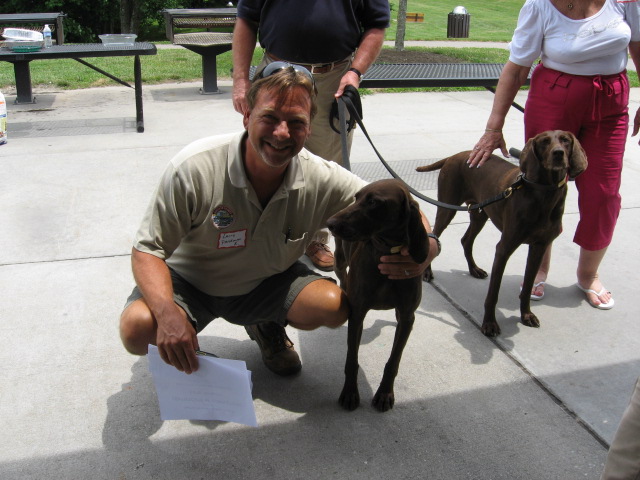
The
Central Piedmont Safety Council (CPSC)
hosted its annual picnic and seminar
on Wednesday, June 10, 2009 at
beautiful Triad Park in
Kernersville. The picnic and
seminar are offered free of charge
to provide an opportunity for CPSC
members to meet and socialize while
attending a training seminar and as
a way for the Council to say thanks
to its members for their support.
More than 55 members enjoyed the
event this year.
The
picnic was a huge success with CPSC
board members serving plenty of
hamburgers, hotdogs and all the
fixings for everyone. Lunch was
followed by a fascinating
demonstration by drug detection dogs
Kita and Spirit, handled by Joe
Glover, owner of National Drug
Search in Greensboro. Glover hid
small samples of various drugs
around the picnic pavilion and then
showed us how well his dogs work.
When the dogs detect a drug they
simply sit on the spot to let the
handler know what they have found.
After the demonstration Mr. Glover
gave an informative talk on
deterring drugs in the workplace and
included tips on how young people
are concealing drug use these days
that will be useful to members with
teenage children at home.
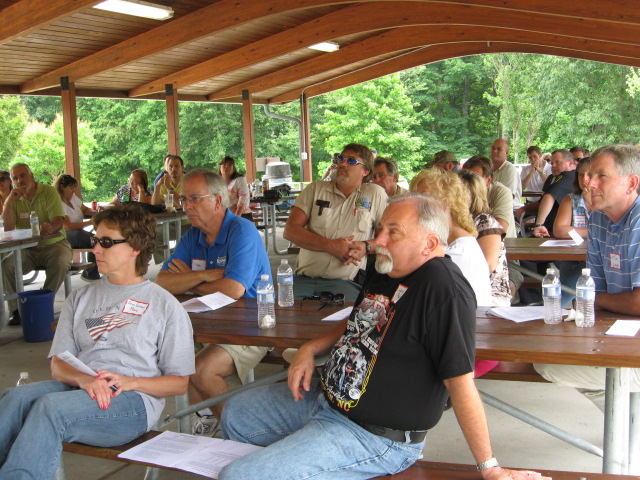
CPSC members look forward to this
annual event each June. We look
forward to returning to Triad Park
in June 2010!
Make plans to join us!
|
Regional Safety Councils

Please... don't forget to support your
Regional Safety Councils by joining
their membership ranks and participating
in their scheduled events. For
membership applications, see the Quick
Links to the right.
|
How to Pass the Time Behind the
Wheel
by Mike Bingham
I read recently -
I forget where, that the average driver
spends about an hour and fifteen minutes
per day in his or her vehicle. Thank
goodness there are pastimes built into
our daily drivers.
A vehicle these days is almost an
entertainment center in and of itself.
Many features we never dreamed of a few
years ago are now an inseparable part of
the package. We can get a car or truck
with a combination AM/FM radio, cassette
player, and CD/MP3 player with a
gazillion CD disc-changer. One vehicle
I was looking to buy came with an
automatic six-month subscription to a
satellite radio service, as well. A
friend of mine has a sport utility rig
with a USB port in it so he can play
music off his thumb drive through the
stereo.
Many vehicles come equipped with
electric seats that move in about six
degrees of freedom, up, down, forward
,backward, and tilt to and fro. Oh
yeah, some even have an adjustable
lumbar support and and adjustable
heating system built into the seat.
Somewhere within easy reach of the seat
(which we can adjust to make almost
anything in the vehicle within easy
reach) are the cup holders, most of
which can hold a 10 or 12 liter drink of
some kind.
The steering wheel on some modern cars
is an engineering marvel. It has
buttons on the back that control the
AM/FM/CD/MP3/cassette deck/satellite
radio system. Buttons on one side raise
and lower the volume, another changes
tracks on the CD player. On the other
side we can change the whole CD if we
want. Close to those buttons are more
buttons that allow us to adjust the
cruise control. We can even change the
direction of the vehicle by turning the
wheel to the right or left!
From the driver's seat we can program
the built-in GPS navigator to help us
find our way to wherever we need to go.
(It even has a function to help find
restaurants and stuff.) The GPS will let
us know what the speed limit is where we
are and how fast we are going. It will
tell us how many miles we have left to
travel and will predict our arrival
time. Scrolling through the menu will
let us see our elapsed time, average
speed, and maximum speed, but wait
there's more... we can adjust the scale
of the map, the brightness of the
screen, and the volume of the lady who
fusses at us while you drive - yeah it's
built in! We can even give her a sexy
accent if we want to. We still need to
look at the vehicle's speedometer,
though, because it gives a real-time
reading of gas mileage and the odometer
mileage for this particular trip.
We can get a DVD player as an accessory.
(If you get one small mirror and some
double-sided tape you can watch the DVD
in your rear view mirror.) Move our
eyes a little and we can see the
temperature displayed on an LED readout
and verify that the direction we are
traveling matches what the GPS says.
Speaking of accessories - most vehicles
these days have a 12-volt socket you can
plug aftermarket accessories into. If
one socket isn't enough, we can buy a
multi-socket adapter to plug a plethora
of devices like laptops, heated coffee
cups, cell phone chargers and radar
detectors into. Get a cheap inverter
and we can plug 120-volt ac household
appliances into it.
A commute to work in one of these modern
vehicles for me would go something like
this:
I get in, fasten the seatbelt and start
the engine. The wife has been driving
the car, so I reach down and fiddle with
the seat adjuster button with my left
hand. The right hand gropes for the
shifter while I look to see what the
temperature is outside. I put the car
in drive and head down the driveway. I
turn on the GPS and punch the button
where I agree not to program it while
driving, (yeah, yeah, don't we all?),
and enter a search for Starbucks. (I
know where it is but I don't know how
far it is from my current coordinates.)
The seat is cold so I turn on the
heater. While I'm at it I add some
firmness to the lumbar support. I
unhook and adjust the seatbelt to get
some slack in it after the lumbar
adjustment.
I turn left on the main road and fiddle
with the seat adjuster button - the
wife's been driving the car, remember.
The navigator has found the Starbucks so
I tell it to GO THERE. The lady orders
me to drive 1.4 miles then turn slight
right. I set the cruise control and
settle in to find something good on the
radio. I hit scan and turn on the radar
detector. One of my cell phones rings
and I pull the wrong one out of its
case. By the time I get the right one
I've missed the call. I don't recognize
the number, so I wrestle the phone back
into its case. I write the number
on my hand and let some firmness
out of the lumbar support so I can get
to the phone easier.
Nothing on the radio, so
I fiddle with the buttons on the
steering wheel and manage to get a CD to
play. I barely hear a beep and
know that an email has come into my
BlackBerry. I press the screen and put
in the code to unlock it. I put it in
again because it's hard to do it right
the first time while driving and I did
it wrong the first time. That's
aggravating... The lady in the GPS is
yelling at me that the destination is
ahead, so I read the email pretty
quickly before I have to pull into
Starsbucks' parking lot.
I get back in with a 10-liter Espresso
and hit the road. I have my work
address in the favorites shortcut in the
GPS so I punch it and reset the cruise
control. The BlackBerry is pinging again
so I get it out and eventually enter the
unlock code correctly. "Call home" is
the message. I put the BlackBerry back
and get my personal cell phone out and
start typing in its unlock code.
Finally get the number dialed. Fiddling
with the seat adjustment button
positions me so I can hold the steering
wheel straight with my knee while I get
a sip of coffee while waiting for
someone to answer the phone.
The radar detector goes off so I put the
coffee back in the drink holder and
fiddle with the button on the steering
wheel that adjusts the cruise control
while looking in the rearview mirror.
Getting hold of the wrong button puts
the CD disk changer into random mode;
pressing the other one adds 5 mph each
time it was pressed. I tap the brake
with my foot to disengage cruise control
and realized that it was a false alarm.
Wife's been driving the car - have to
adjust the rearview mirror. I resume
speed and figure I might as well call
511 for a traffic report for I-40. (I
won't be going anywhere near I-40, but
what the heck.) The voice command lady
at 511 can't understand my accent, so I
give up and turn the radio back on.
Can't figure out how to get out of
random mode on CD player.
Thought I heard a phone ringing but the
radio is too loud. Wasn't the phone(s)
but I figure I better put them on
vibrate just in case. Seat is too hot
so I turn down the temperature. Looks
like it's 10 degrees outside. Darn
thing is set on Centigrade so I fiddle
around and figure out how to get it back
to Fahrenheit. Mirror is still a little
off - got it. Use the switch thingies
to adjust the side view mirrors. Looking
good. Play with the turn signals - I can
see arrows flashing on the mirror when
the signal is on.
The GPS lady is ordering me to turn
right. Since I'm at work anyway I
fiddle around and find the switch that
turns the GPS off and push, no, slide
it. It's been a busy five miles. I
didn't get to play with everything the
car has but there's always tomorrow.
I park at the far end of the parking lot
so other people won't park too close.
I'm afraid they will ding the doors.
You can't be too careful with a nice
car.
While the above is an exaggeration, I'll
bet it isn't far off from a lot of
real-world commutes. If you or your
employees can take a highlighter to the
text above and mark some at-risk
behaviors you engage in, it may be a
good idea to rethink your priorities.
It really wouldn't be hard to engage in
all of the behaviors above on even a
short trip. I've seen people brushing
their teeth, flossing their teeth,
shaving, putting on mascara, reading
newspapers, driving with their elbows
and other dangerous things out on the
road. A guy told me the other day that
he was passed by a guy on I-40 once who
was picking a banjo while driving!
At 60 mph, a vehicle is traveling at 88
feet per second. If you take your eyes
off the road for one second, and do it
sixty times while you are driving on a
trip, your vehicle has effectively
traveled one mile unattended. Good luck
and inertia keeps us heading straight
most of the time, but if something
unusual happens while we are "away",
that's when disaster can strike. We
need to set the vehicle up to be driven
before we move it, then we must drive
the vehicle while we are behind the
wheel. A sudden stop from 88 feet per
second can be hard to survive.
Editor's Note:
Mike
Bingham is a freelance writer living in
Franklin, NC. He says working in the
safety field is a privilege that has to
be experienced before it can be
appreciated.
|
NCIC Video Library
Check out our
Video Library !
View our online
Video/DVD listings. The new listings are
in
RED.
To view the rest of our Library and
download the REQUEST FORM, please
CLICK HERE
|
Training and forethought prepare
you for emergencies...
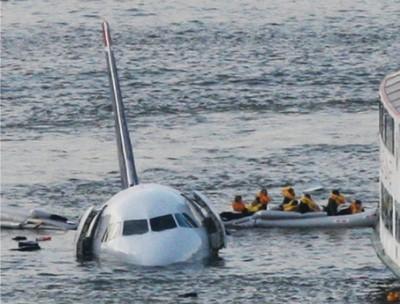
Be Prepared!
The passengers and crew
of US Airways Flight 1549 from New York
City to Charlotte, North Carolina
expected a routine flight on January 15,
2009. But, approximately 2 minutes after
takeoff, the plane struck a flock of
birds and lost power in both engines.
The plane was at low altitude (about
3000 feet, 1000 meters), had no power,
and was in a large urban area. There was
danger, not only to passengers and crew,
but to tens of thousands of people on
the ground. It was time for the crew
(Captain Chesley B. Sullenberger, First
Officer Jeffrey B. Skiles, and Flight
Attendants Sheila Dail, Doreen Welsh,
and Donna Dent) to put everything they
had learned from many years training and
experience into practice, and quickly.
The pilots determined that they could
not re-start the engines, and did not
have sufficient altitude to glide to any
airport. Their only option was a water
landing in the Hudson River. The cabin
crew prepared passengers for the water
landing, while the pilots prepared and
flew the aircraft. They left the landing
wheels retracted, and used the ditching
button that closes all valves and
openings underneath the aircraft to slow
the rate of flooding in case of a water
landing. The pilots successfully landed
in the Hudson River west of mid-town
Manhattan. All 150 passengers and 5 crew
members safely evacuated the plane and
were rescued by nearby commercial and
rescue boats.
The time from when the airplane struck
the birds until it landed in the river
was about 6 minutes! The entire
crew was later awarded the Master's
Medal of the Guild of Air Pilots and Air
Navigators for "a heroic and unique
aviation achievement."
What can
you do?
A manufacturing process, like a modern
airplane, is a complex machine. Most of
the time, it works very well, but you
never know when something might go wrong
and you will have to respond to an
emergency. You must always be prepared
by understanding your plant, how it
works, how it will respond to your
actions, and what to do in an emergency.
And, you can also understand the hazards
of your plant,
anticipate what might go wrong,
and how you should respond.
· Take training seriously. For example,
every airline flight begins with a
safety awareness announcement - do you
pay attention to it? Emergencies are
rare, but they can happen to you.
You must know how to respond.
You may not have much time to decide
what to do, and preparation and training
are critical to proper action.
· Before starting any activity,
take a few moments to think about what
might go wrong, what the potential
consequences are, how your equipment
will react, and what you will do.
If you don't know, get help from your
supervisor, and do not start the
activity until you are comfortable that
you understand how to respond to an
emergency.
· Participate in emergency response and
"table top" drills so you are better
prepared.
|
|
Warm Cookies
and Cold Milk
By Michael Nance
In the April newsletter I
mentioned a few items that were on my "to
do" list. Things that are not an immediate
need, but nonetheless things that I plan on
doing soon. Yes, my wife got wind of it and
last week she decided to let me know that
most of them were still on the list.
What makes "this past week" so special is
that both of my children were away for the
week. My son experienced life at the Boy
Scout camp with all of the bigger scouts,
earning four of his first merit badges. My
daughter was at Camp Tekoa near Flat Rock
with other Methodist children. Thus, my
wife and I had a week of peace and quiet,
sort of. She decided to add to my list of
things to do.
One of the additions was to wash the dogs.
Not one of my top ten. A long time ago we
bought one of those plastic baby type pools
that's probably 6 feet across and 12 inches
high. I got it out and noticed spiders all
over the underneath side. (It was stored
under an outdoor shed). It also sported a
cut about 4 inches long, so to the trash
pile it went and to the store I went to
purchase another one. When I got it home I
saw a piece of paper in it and thought
someone lost their shopping list, but it was
a Warning letter from the company that makes
them. I thought it was odd to have a
"warning" about pool safety for such a small
"bowl". But it did carry some good
information:
1) Children under five years old are
especially prone to drowning in small pools.
2) Drowning occurs silently and quickly and
can occur in as little as 2 inches of water.
3) Keep children in direct sight, stay
close, and actively supervise them when they
are near or in the pool.
4) Do not leave toys inside pool when
finished using since toys and similar items
might attract a child to the pool.
5) When searching for a missing child,
check the pool first, even if the child is
thought to be in the house.
There were a few other warnings but these
were the ones that caught my eye. I didn't
know about the kids under five being prone
to drowning. I also was a little surprised
to learn that two inches could be
dangerous. We've all heard about buckets of
water and how a child could get stuck and if
it had water in it, drowning can occur. I
just didn't think about it being two
inches. The number three above made sense.
Again, I never thought about toys in a pool
that could attract. I sat back and thought
about my kids and how they did scoot towards
a toy before they learned to walk. So I
think that's a good piece of advice. Then I
read the fifth one. Probably in a state of
panic, we would run all through the house
and even scan the yard before actually
looking in the pool. True, we might scan
the pool but perhaps not go to the edge and
really look. Since 3 out of four neighbors
have a pool in their yard, I'll remember
that one. There are many other safety
things to think or have if you are near or
have a pool. Take time to refresh yourself
on the safety aspects to your specific
location if it applies.
Another thing that my wife decided to put on
the list was to "replace the tub and shower
plumbing. Sounds pretty easy right? Hmmmmm,
don't think so. Especially if you own a
house that's over 30 years old. Some things
just don't match the items they sell at
Lowe's or Home Depot. Their obsolete. I
tried to make this job a little easier by
buying everything I could possibly need to
tear out the old pipes and to install the
new ones. Copper pipe (Man has that gotten
expensive!), fittings, flux paste, new
propane cylinder, and an assortment of other
items.
Being the safety person that I am, I thought
the "other things" I would need. Fire
Extinguisher close by, the first aid kit,
and a bucket of water. Why a bucket of
water? Since I had to shut off the entire
house's water supply, I needed something to
cool down those copper fittings after
sweating them. Why A fire extinguisher?
Some of these fittings were being sweated in
the wall cavity and I had a risk of a fire
using the propane torch. (I did use old
flashing material to guard the area) Why a
first aid kit? You need to read past
editions of this newsletter. Even with
leather gloves on, those pipes get really
hot after being torched. I know, I
experienced.
Point being that even a simple job can turn
out to be a major problem if you don't
prepare yourself and the work area. Be
ready for the unexpected. Read, follow, and
understand the safety rules that come with
your tools and think about what you're
getting ready to do. Don't be in a rush.
The associates at Lowe's told me this should
take about 2 hours if I was replacing an
existing system. Holes are already in the
walls, etc. But this took me about 5
hours. (It did include a trip back to
Lowe's for a few forgotten fittings). The
job took longer but it was done safe and
with an outcome that was satisfactory. The
only problem I had was the slight mess left
on the closet carpet. My wife decided to
clean all the carpets while the kids were
gone, so naturally I had to make a mess.
I guess my goal for this edition is to
remind ourselves that even what appears to
be a simple job (plumbing) or a simple item
(small plastic pool); the end result could
be a disaster if proper safety and planning
is overlooked. Take time to scan your area
of work and heed warnings that are posted or
a part of your work location.
One last item: Most of us have heard or read
the book: All I really need to know, I
learned in Kindergarten" by Robert Fulghum.
It was interesting to go back a read some of
the things I learned:
Share everything
Play fair
Don't hit people
Put things back where you found them
Clean up your own mess
Don't take things that aren't yours
Say you're sorry when you hurt somebody
Warm cookies and cold milk are good for you
There's more. One of the statements on this
site
has this to say:
"Think of what a better world it would be if
we all - the whole world - had cookies and
milk at 3 o'clock in the afternoon and then
lay down with our blankies for a nap. Or if
all governments had as a basic policy to
always put things back where they found them
and to clean up their own mess." Hmmmmmm.
What if?
Editor's
note: Michael Nance is the NCIC Blue Ridge,
Southern & Western Piedmont areas Safety
Representative. If you are interested in
having one of our programs in your area,
please give Michael a call at 919-218-9047
or email him at Michael.Nance@ic.nc.gov
|
From the Desk of
Dennis Parnell
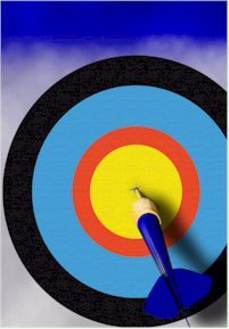
Director Safety Education
Are You Bored At Work?
Anyone can become bored with
their job, but if a feeling of monotony has
crept into your worklife, the first thing to
do is to try to figure out why. Once you've
determined what kinds of things could be
causing your boredom, you can begin to look
for solutions.
For example, you could be experiencing
boredom because your job does not present
you with an intellectual challenge or an
occasion to use your creativity. People for
whom this is a problem might feel that they
are just going through the motions each day
and not truly engaging in their work.
Boredom could also result if you don't have
enough responsibilities to keep you busy, or
if the job does not fit your personality.
Once you've determined what it is that's
causing you to be bored at work, the
solution could be as simple as asking your
supervisor for more responsibilities or more
challenging work. If your current job can't
be modified to better hold your interest,
perhaps it's time to examine other
opportunities within your company - you
might discuss career-pathing with your
supervisor.
While you may not immediately be able to
change positions, refocusing on what you
need to do to achieve future goals might
alleviate some of the tediousness of your
job. You may be able to find educational
resources to help you to become more
qualified for a job that would be more
fulfilling to you. Networking within your
company can also be extremely valuable if
you are hoping to climb the ranks in the
future. Plus, social interaction can go a
long way towards making a dull job more
bearable.
You might also consider the possibility that
your work life isn't the problem. If you're
bored, consider examining your personal life
as well. It could be that you're not getting
what you need when you're not at work, and
you're relying too much on your job to
provide you with the fulfillment you crave.
Doing things that spark your interest
outside of work might be enough to help you
to change your attitude.
Now you know. Dennis :)
|
Insight!
Fun and useless tidbits

-
A penguin swims at a
speed of approximately 15 miles per
hour.
-
A person uses
approximately fifty-seven sheets of
toilet paper each day.
-
Approximately one out of
four injuries by athletes involve the
wrist and hand.
- Approximately 125
people die in the United States from an
anaphylaxis to foods each year.
- The Joshua tree is
the only tree that grows in California's
Mojave Desert.
- The hyoid bone in the
throat is the only bone in the human
body not joined to another.
|
Selecting
the right loaf of bread...
With all of the "healthy" breads available
today, it can be confusing to pick out a
loaf of bread that is healthful and low in
fat. Here are a few tips so you can do just
that:
- Read the ingredients section on the label.
There should be at least three grams of
fiber per serving. Also the words "whole" or
"whole grain" should precede other
ingredients such as wheat, oats, or barley.
- Make sure you know what the serving size
is. As a rule, one serving of bread should
equal about one ounce and should have about
90 calories. Many types of bread labeled
"light" have thinner slices so that you can
actually get two or three slices per ounce.
- Gourmet breads can house a lot of fat, so
be sure to read the label. Your bread, if it
is diet friendly, shouldn't contain more
than two grams of fat per serving.
- Don't be fooled by misleading labels.
While it might be nice to have calcium or
protein added to the bread, the most
important ingredient in your bread is whole
grains.
|
 When
to wash your hands... When
to wash your hands...
Unfortunately, science shows
that people don't wash their hands as often
as they should. In fact, a recent
observational study showed that only 77
percent of us wash our hands in public
restrooms!
The Centers for Disease Control and
Prevention encourages you to wash your
hands:
- Before eating;
- Before, during, and after handling or
preparing food;
- After contact with blood, vomit, nasal
secretions, saliva, or other body fluids;
- After using the bathroom or changing a
diaper;
- After handling animals, their toys, or
waste;
- After touching a trash can, cleaning
cloth, drain, soil, or anything that could
be contaminated;
- Whenever your hands look dirty;
- Before dressing a wound, giving medicine,
or inserting contact lenses; and
- More often when someone in your home is
sick.
Believe it or not, many of us also don't
know how to wash our hands properly. Using
soap, you should rub your hands together
vigorously for at least 20 seconds, making
sure to lather all surfaces of your hands.
Rinse your hands well under running water
and dry them thoroughly. It's not a bad idea
to us a paper towel to turn off the faucet,
since pre-handwashing germs could be
lingering on the handles.
What about
alcohol-based hand rubs?
Unlike soap and water, alcohol-based hand
rubs kill germs fast and can significantly
reduce the number of germs on your skin.
While hand rubs should not replace proper
handwashing, they may be used when soap and
water are not available or in addition to
handwashing. Apply the rub to the palm of
one hand and rub your hands together. Be
sure to rub it over all hand and finger
surfaces until your hands are dry.
|
What Folks Are Saying...
Steve Oakley and I want to
express our appreciation for having Michael
Nance presenting two classes on Job Hazard
Analysis/Job Safety Analysis and PPE.
We feel the classes were a success and we
anticipate doing more of them and other
subjects this year.
Thanks for your support and cooperation and
thanks to Michael for a job well done.
Dennis Knapp
Safety Administrator
City of Gastonia
_____________________________________________________
Just wanted you to know that all went well
with our PIT Training here at the airport
yesterday. That young man (Jim Gilreath) was
the best trainer we have ever had here. He
kept his training moving without a lot of
uhs and thoroughly covered the material. In
the hands on phase, he spent extra time with
Karen who is our rookie on staff. He was
pleased that even though she was not all
that smooth in her movements, but that the
movements were slow and deliberate and
safely got the job done.
CU,
David Shoaf
Forsyth County
_____________________________________________________
Eric and Michael,
I appreciate you coming
to Taylorsville to put on a saftey
school for the Town of Taylorsville. The
school was very informative and is
exactly what we needed. The participants
in the school were employees form the
Town of Taylorsville, West Iredell Water
Corp. and Energy United Water Corp. We
did not charge anyone for the school,
the College was kind enough to allow us
to have the room free of charge.
Thanks again,
David Robbinette
_____________________________________________________
Jim: Thank you for coming by
Greensboro yesterday and putting on the
safety meeting on falls, slips and trips. I
felt it was very well taught and beneficial
to our employees.
In addition I felt you understood the
audience and the work they do and you made
the presentation fitting to our work; which
is warehousing.
Once again, thank you for the time you took
to come to Duke Energy.
Mark Godley
Duke Energy
|
|
About N.C. Industrial Commission
Safety Section
The N.C. Industrial
Commission
Safety Education Section stands ready to
assist you with your Safety training needs.
We offer a variety of courses, designed to
suit your needs. Please give one of our
Industrial Safety Representatives a call.
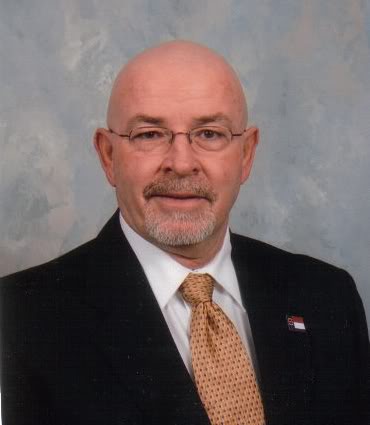 DENNIS
PARNELL DENNIS
PARNELL
Director Safety Education
919-218-3000-Cell
919-807-2602
Dennis.Parnell@ic.nc.gov
 KIM
NADEAU
Program Assistant
919-807-2603
919-218-9049-Cell
Kim.Nadeau@ic.nc.gov
 RANDY
CRANFILL RANDY
CRANFILL
Western Carolina Area & APCAP & APW
Coordinator
919-218-2986
Randy.Cranfill@ic.nc.gov
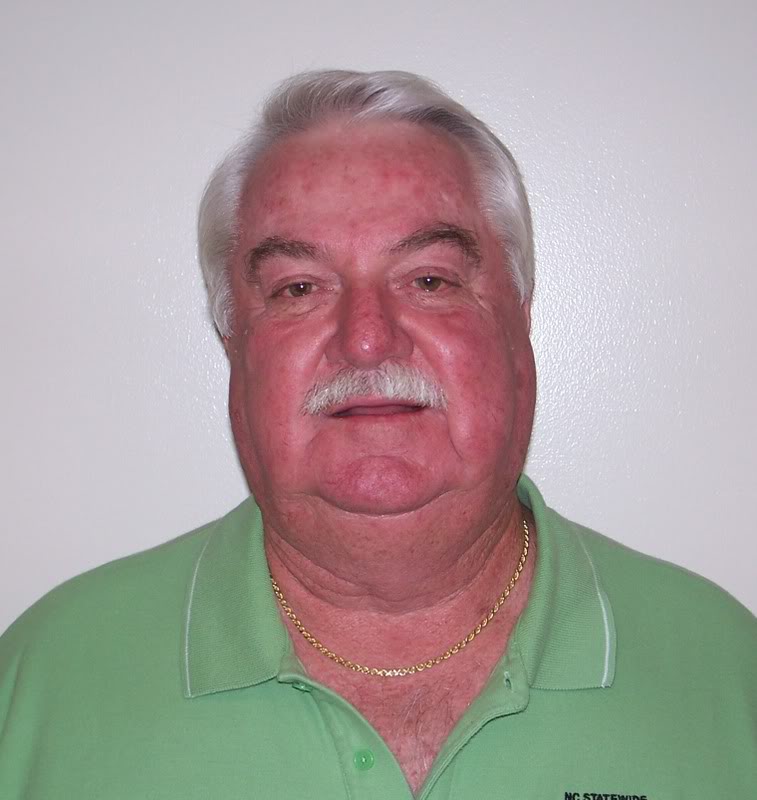 ALVIN
SCOTT ALVIN
SCOTT
Eastern & Northeastern Areas, Eastern
Defensive Driving Instructor
919-218-2792
Alvin.Scott@ic.nc.gov
WE ARE WORKING FOR YOU!
|
|
|
|
Quick Links VIDEO
The next time you watch this classic western
with Clint Eastwood riding along, lonesome and
forlorn - just remember the background music.
This film clip
says he was not alone
The
Good, the bad & the ugly!
Turn up the sound!
|
|
Quick Links
Construction
Back to Basics
|
|
Quick Links
General
Industry
Avoiding
Common Office Injuries
|
|
Quick Links
Fleet Safety
Keeping your seat belts safe
|
|
Quick Links
CENTRAL
PIEDMONT SAFETY COUNCIL
Membership
Brochure
|
|
Quick Links
EASTERN
CAROLINA SAFETY COUNCIL
Membership
Brochure
|
|
Quick Links
SOUTHEASTERN SAFETY COUNCIL
Membership
Brochure
|
|
Quick Links
WESTERN
PIEDMONT SAFETY COUNCIL
Membership
Brochure
|
|
Quick Links
MID-STATE
SAFETY COUNCIL
Membership
Brochure
|
|
Quick Links
BLUE RIDGE SAFETY COUNCIL
Membership Brochure
|
|
Quick Links
NORTHEASTERN SAFETY COUNCIL
Membership Brochure
|
|
Quick Links
WESTERN
CAROLINA SAFETY COUNCIL
Membership Brochure
|
|
Quick Links
NC RURAL WATER ASSOCIATION
|
|
Quick Links
SIGN-UP FOR OUR NCIC SAFETY
BULLETIN
Email/Newsletter
|
|